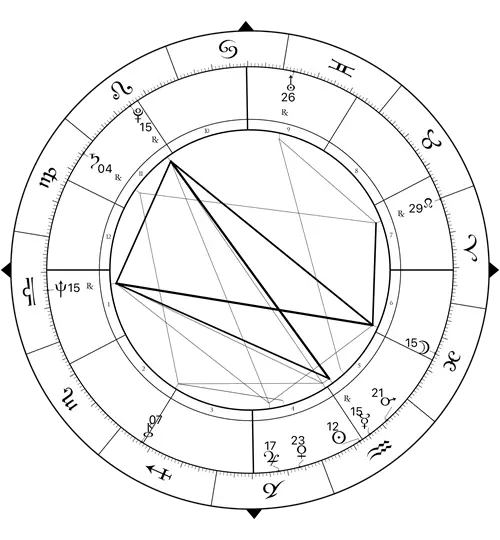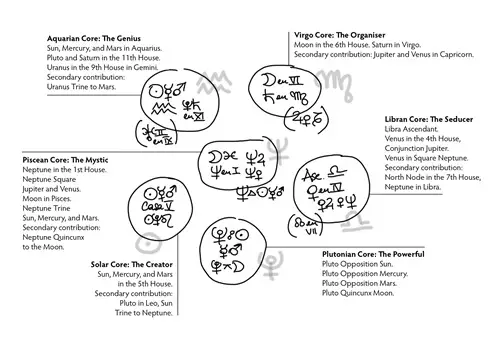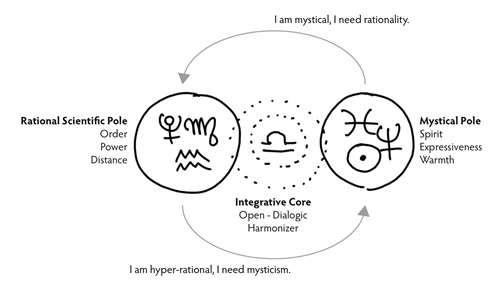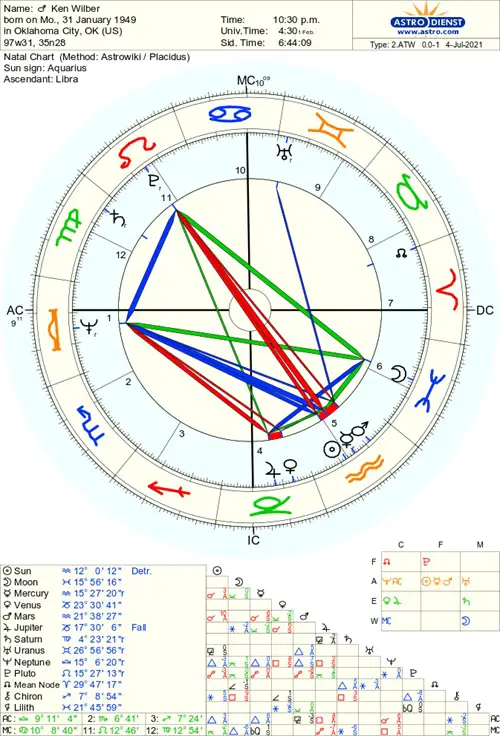The light and shadow of Ken Wilber according to astrology, Alejandro Christian Luna (original) (raw)
TRANSLATE THIS ARTICLE
Integral World: Exploring Theories of Everything
An independent forum for a critical discussion of the integral philosophy of Ken Wilber
 Alejandro Christian Luna is an Astrology Consultant and Teacher, Professional Ontological Coach, and Graphic Designer. Trained in Psychosynthesis. Co-author with German artist Nil Orange of the Visual Zodiac, Visual Zodiac Pro, and Orange Luna Tarot card decks. He has presented at conferences and workshops in Argentina, America, and Europe. Contact: [email protected]. www.astrohologia.com.ar
Alejandro Christian Luna is an Astrology Consultant and Teacher, Professional Ontological Coach, and Graphic Designer. Trained in Psychosynthesis. Co-author with German artist Nil Orange of the Visual Zodiac, Visual Zodiac Pro, and Orange Luna Tarot card decks. He has presented at conferences and workshops in Argentina, America, and Europe. Contact: [email protected]. www.astrohologia.com.ar
SEE MORE ESSAYS BY ALEJANDRO CHRISTIAN LUNA
Alejandro Christian Luna
The following text is part of the book EcoAstrology, by Vanesa Maiorana and Alejandro Luna.
We will undertake a reading of Ken Wilber's biography through these six subpersonalities to understand how they manifested and interrelated throughout his life.
Kenneth Earl Wilber was born at 22:30 on 31 January 1949, in Oklahoma City, United States. He is primarily known as a theorist, a philosopher, and also a mystic. His life's work focuses on creating a “theory of everything,” in which he aims to integrate the visions of mysticism, science, epistemology, spirituality, postmodernism, evolution, psychology, and other disciplines, to achieve an integral meaning of the cosmos.
An only child of a father who had been an aeroplane pilot in World War II and a mother interested in art, fashion, and interior design, young Ken soon stood out for his intelligence; he was always at the top of his class. To avoid arousing jealousy or envy, he tried to please and socialise with his peers. He also excelled in sports, which further increased his popularity among his peers.
In 1968, Wilber enrolled to study medicine at Duke University in North Carolina, but he soon became disillusioned with the course. During the hippie and flower power era, he was inspired not so much by the psychedelic culture as by Eastern and spiritual literature, such as the Tao Te Ching, Krishnamurti, Alan Watts, and D.T. Suzuki.
The following year, he left Duke and returned to Nebraska, where he graduated with a degree in chemistry and biology. He studied these subjects because they were easy for him and left him time to dedicate to his passions: researching Eastern philosophy and Western psychology.
In 1972, he met Amy Wagner. They moved in together, and a year later they married. Wilber worked as a private tutor, waiter, cashier, and dishwasher for years. He liked being a dishwasher because it was a job that provided him with stability while allowing him to write. To train his writing, he dedicated himself to copying entire books by Alan Watts, word for word.
At the age of 23, he wrote a manuscript in three months that he titled “The Spectrum of Consciousness,” in which he speculated that human consciousness could be represented as a spectrum of different bands, and that all schools of psychology and spirituality could be represented in one of these bands, thus promoting an integral psychology.
Published only in 1977 by a theosophical publisher, it was an unexpected success, so much so that he began to be called “the Einstein of consciousness.” Reflecting on his own ideas, he realized that he needed to update some concepts based on his new insights, and so he wrote several works in the following six years: “No Boundary,” “The Atman Project,” “Up from Eden,” “A Sociable God,” “The Holographic Paradigm,” and “Eye to Eye”; in addition to articles in specialized journals.
As editor of the ReVision magazine, he moved to Cambridge, on the outskirts of Boston, while his wife Amy received a job offer that required her to move to another city. It was a friendly separation that had been brewing for some time. Ken did not like living in Cambridge, so he moved to a town north of San Francisco, invited by some friends.
In San Francisco, Wilber met Treya, they fell in love and married within a few months. Ten days after the wedding, Treya was diagnosed with breast cancer. Ken dedicated the next five years to caring for her and accompanying her. From this experience came the book “Grace and Grit” (published in 1991), in which Wilber narrates the painful process of his wife's illness until her death in 1988.
While he cared for Treya, Ken was unable to write, although they lived off the royalties from the sales of his books. Afterward, he spent about three years in voluntary seclusion, reading, meditating, and studying. In 1995, he launched one of his most acclaimed works, the first volume of a series, "Sex, Ecology, Spirituality," in which he critiques various aspects of Western culture, as well as movements like New Age.
In 1996, he published a synopsis aimed at the public: "A Brief History of Everything," which is one of the best-selling books in his vast output. There, he presents an integrated model encompassing topics as diverse as neurobiology, Jungian archetypes, sociology, hermeneutics, systems theory, post-structuralism, Vedanta Hinduism, economic systems, transpersonal states of consciousness, and the path to Buddhahood.
Wilber strives for his AQAL (all quadrants, all levels) model to be a map where the most diverse topics can be articulated, thus benefiting the scientific, political, psychological, religious, and spiritual worlds.
The years 1998 and 1999 were very productive. He wrote "Integral Psychology," "A Theory of Everything," and the novel "Boomeritis." In 1999 (at age 50), his collected works were published.
Although the publication of "Sex, Ecology, Spirituality" was a kind of renaissance after the ordeal with Treya, Ken's health was severely compromised due to a deficiency of the enzyme RNase, which can cause severe degenerative conditions such as multiple sclerosis, myalgic encephalomyelitis (chronic fatigue syndrome), rheumatoid arthritis, and immune system problems. It appears he was poisoned by toluene in Lake Tahoe, which received toxic waste from a nearby industry.
This chronic illness forced him to be bedridden for a long time, suffering from pain, lack of oxygen, and successive infections that gradually undermined his body and emotions. Despite this, he continued to meditate and write.
Aware of the impact his work had and motivated by his thousands of readers and admirers, a group of experts from various fields convened in 1999 to establish the Integral Institute, and from there to spread Wilber's ideas to the world. Seminars were created, courses and lectures were offered, websites were designed, and work was carried out on an Integral University. Leaders, artists, and thinkers such as Bill Clinton, Al Gore, Tony Robbins, Alex Grey, David Deida, and Tony Schwartz strongly supported the Institute.
The 21st century seemed poised to be illuminated by Ken Wilber and his integral model, where science, religion, politics, and art could finally be harmonized from a higher collective consciousness.
However, as we know, too much light attracts a dark shadow.
However, as we know, too much light attracts a dark shadow. There came a time when the impeccable and robust Wilberian model began to show cracks. Frank Visser, a scholar and great admirer of Ken's work, had an online website dedicated to integral thought, where criticisms from various experts in the fields Wilber had supposedly "integrated" began to appear. In many articles, several authors pointed out weaknesses, contradictions, biases, and errors in the integral model.
But it was not these criticisms that tarnished Ken Wilber's image but his untimely reaction to them. What could have been an opportunity to refine and deepen the AQAL model—and a chance for constructive self-criticism by Wilber and other leaders of the Integral Institute—turned into a direct attack on his critics, using aggressive and even vulgar language.
For many, this was a breaking point, where the "Einstein of consciousness," the "Aristotle of our time," showed his most regressive and childish shadow. The emergence of Wilber's shadow was a prelude that revealed the shadow of the integral community, as many of its members could be seen displaying an attitude of intellectual and spiritual superiority by believing they had reached the highest levels of development, supported by the hierarchical orders of consciousness postulated by Wilber.
Furthermore, some gurus sponsored by the Integral Institute—who were supposed to be at the forefront of new spirituality—found themselves embroiled in confusing and scandalous situations. Rabbi Marc Gafni was accused in Israel of child abuse. Andrew Cohen, one of the founders of the Integral Institute, was accused by some of his disciples of emotional abuse, physical violence, and financial fraud. Genpo Roshi admitted to unethical sexual conduct and was criticized for greed for charging $50,000 per person to participate in a Zen retreat. Neither Ken Wilber nor his collaborators clarified or denounced these events. Worse still, they claimed that their critics were "first-tier thinkers" who lied to attack a higher and more evolved level of consciousness that they could not understand.
The Integral Institute, created as the most suitable place to research and convey Wilber's meta-theory and thus engage with the scientific academy, gradually transformed into an organization machine for courses and seminars with a commercial orientation, adopting New Age-like postulates they once criticized. For example:
“Join renowned author, teacher, and living legend Ken Wilber. Discover a revolutionary new technology for your mind to activate its superhuman potential. Anyone reaching this revolutionary stage of development is literally becoming superhuman compared to the rest of the planet. A small percentage of the human population, about 5%, is experiencing a 'quantum leap' into this emerging stage of evolution.”
To date, Ken Wilber has written over thirty books. He is the leading reference for the evolution of consciousness and the attempt to synthesize science and spirituality. Although continuously cited by intellectuals, artists, and politicians, and his writings extensively discussed by critics, and his person loved by thousands of followers and readers, his work remains neither endorsed nor esteemed by the scientific community.
The subpersonalities of Ken Wilber


The protocol for analysing natal charts is very complex (as detailed in the book AstroHology, Volume One). Here, we synthesize the chart based on energy cores, understood as subpersonalities in the style of psychosynthesis.
We will undertake a reading of Ken Wilber's biography through these six subpersonalities to understand how they manifested and interrelated throughout his life. It is important to emphasise the power that transpersonal polarisations[1] have on the manifestation of all cores, particularly those represented by other qualities (not related to the transpersonal), such as in the case of the Organiser and the Creator. Furthermore, it is crucial to be attentive to the balance of Elements, as the Principal Air/Auxiliary Earth pair largely defines the way Wilber perceives and operates in the world.
The subpersonality of the Genius is one of the first to appear in his life and remains active over the years. Initially, as a child of extreme intelligence and quick thinking (he was called “the brain”); then, as a young man who found biology easy and felt like a rare bird among his early academic and university peers. As we mentioned, he was dubbed the “Einstein of consciousness” for his extraordinary contributions in the field of transpersonal studies. From his youth to his maturity, he was known for his bald head and muscular physique, worked out in the gym. Surprisingly, at the age of 70, he began to appear wearing a woman's wig.
Generally identified with the opposite pole of the Uranian polarisation, all his intuition and creativity were poured into creating hundreds of grids, lists, classifications, tables, diagrams, structures, and models; in working, reading, and writing full-time for many consecutive months; and in defensively shutting down to critical comments. He first valued spiritual traditions and then the scientific method. He also sought to renew and transcend them.
The subpersonality of the Organiser brings its systemic vision, work capacity, and talent for ordering, summarizing, and cataloguing everything that comes its way. Loving routines, it aids with issues linked to meditation, work, diet, physical exercise, and all activities necessary to navigate his degenerative disease. The Organiser cooperates, with its particular talent, with the opposite Uranian and Neptunian poles.
The subpersonality of the Mystic is conditioned by the direct polarisation of Neptune. This character first manifests during university years, when, instead of being interested in medicine, he plunges into philosophical, spiritual, and mystical texts. From there, we see that this subpersonality gave him the meaning and direction to create the great work of his life, expressed in one of his latest books to date, "The Religion of Tomorrow."
The subpersonality of the Creator is based in the Sun enhanced by Pluto, archetyped by Neptune and activated from the Fifth House, with all that specifically Aquarian creative self-expression. It carries intellectual and spiritual leadership and serves as the institutional director. It also provides coherence and vitality to the other parts that inhabit his ecosystem. Hastily, it appears as whimsical and narcissistic, fundamentally when criticism intensifies towards his integral model, which he may have interpreted as direct attacks on his person.
The subpersonality of the Seducer may seem less obvious than the others; however, Wilber has always been interested in aesthetics, specifically from his bodily image. The love of his life, Treya, was like a pinnacle experience for this Venusian and Libran core. He had relatively few partners he committed to, but some of his acquaintances commented that he was quite a womanizer. On the other hand, he always tried to unite and harmonize everything he felt as the opposite sides of the same coin: science and religion, body and spirit, culture and nature, brain and heart. The integral model seeks to bring harmony and elegance to the extreme complexity of existence.
The subpersonality of the Powerful operates fundamentally from his AQAL vision, and the intensity in his way of working, writing, and thinking. In his extensive bibliographic production, titles such as "No Boundary," "A Brief History of Everything," "A Theory of Everything," "Integral Life Practice," "The Integral Vision" stand out, where the words "everything" and "integral" reveal omniscient pretensions in an omnipotent attempt. That is, something typical of the direct Plutonian polarisation.
John Heron, a critical author of his work, believes that
"his account of the spiritual path seeks to be controlling, dominant, hegemonic, devouring; it is implicitly intolerant and scorns all religious beliefs and practices that cannot be assimilated into his absolutist framework. Wilber writes with analytical disdain about the poor fools who cannot understand his absolute viewpoint."
Given what we know of Ken's private life, we do not know what type of relationship he had and has with his subordinates and associates, but we see that he responds disparagingly to his critics.
From the double bind to the ecological self
We can hypothesize how these six energy cores might operate through a significant double bind. One pole would consist of the tougher and more rational part that craves power. It is composed of the Genius, the Organiser, and the Powerful. The other pole is sensitive, spiritual, and expressive, and includes the Mystic and the Creator. The Libran subpersonality of the Seducer seeks the meeting and harmony between both poles.
From his biography, we notice the attempt to unite, harmonize, and integrate both perceptions; in his youth, he studied medicine and biochemistry but also read the great mystics. His early books tried to provide a rational and orderly framework for the evolution of consciousness. Later, he sought to integrate science and religion, and further on, he created the integral model AQAL (All Quadrant All Level), where all possible manifestations of reality—from subatomic quarks to the subtlest states of consciousness—find their perfect place in the great integral grid.
Wilber always sought validation from science regarding spiritual phenomena. By criticizing and arguing, rationally and acidly, the tenets of the New Age movement, he tried to demonstrate that there was a childish level of spirituality and another, superior and evolved, that addresses the challenges posed by the scientific paradigm.
With more than thirty books published and the creation of an Integral Institute, the irony is that the scientific academy virtually ignores him, while his work is found in the New Age section of bookshops.
On the other hand, some scholars of religions and spirituality see him as a fundamentalist of his own model, unable to properly value other spiritual perspectives that are not the ones he practices and, if that were not enough, they consider him merely a seller of courses, congresses, and talks that promote a very capitalist consumerism that is neither transformative nor emancipatory.
The underlying issue is that Wilber's own consciousness oscillates between the two poles of the double bind.
With more than thirty books published and the creation of an Integral Institute, the irony is that the scientific academy virtually ignores him, while his work is found in the New Age section of bookshops.
When, from the mystical pole, he supports the existence of a transcendental Eros that drives evolution from atoms to bodhisattvas, it causes scientists to see him as a creationist charlatan who does not understand how evolution works, and who is constantly repeating the same ideas. When, from the scientific pole, he maintains that most people in spiritual search perceive from a childish and pre-rational level of consciousness, it causes a sense of betrayal and misunderstanding among much of his readership, who consider him a fundamental theoretical reference.
And so, despite Wilber's great and meritorious efforts to give scientific legitimacy to the spiritual dimension and to endow objective reality with post-metaphysical significance, it appears that his entire life has oscillated between these poles, enjoying the near-fanatical admiration of his followers and suffering disdain and rejection from academia.
Is Wilber a tyrant or a mystic? A vile merchant or someone who transcended the temptations of matter? A sharp critic or a very sensitive being? A genius or a copycat?

These questions could only be fully explored and perhaps answered in several personal encounters with him. For us, we are left to hypothesize from what we can analyse from the various factors of his Natal Chart and the observation of his environments.
Beyond what we can interpret about the polarized play of the double bind between the cerebral and the spiritual sides, it can be affirmed that the Venusian/Libran core is the most capable of attempting a fruitful dialogue between both stances.
The conscious observation of the energy cores, operating from the Libran integrative core, can peacefully accept the existence of each of the poles without trying to prove, convince, or force one thing to the other; which, after all, is what produces all the conflict.
This objective observation of the internal characters—which is what we work on in an astrological consultation—reveals the interplays among the various characters, and it is possible to extract the healthiest version of each of them.
Thus, the Genius is inspired by the subtle perceptions of the Mystic, while the Organiser arranges the information in a rational and intelligible manner, with the unique creativity of the Creator. The Powerful provides the fuel that endows the team with a great capacity for work and delves deeply into the mystery; meanwhile, the Seducer harmonizes the whole ensemble by contributing the elegance of any memorable theory. The Seducer can become a conciliatory agent, capable of bringing into reality the union between spirit and matter, of uniting what is separated, remaining open, and finding new levels of harmony among all opposites.
The potential unfolding of the ecological self and its shadow
The ecological self goes beyond what consciousness sees when it observes the different cores or internal characters. It is capable of not only registering its internal system to make room for its parts and the dynamics they generate with their "outside" but also has the faculty of constantly observing the impact that its actions have on the environment and consciously registering its shadows.
Ken Wilber has stood out for seeking a theory that explains and encompasses everything, showing a systemic quality of thought. From our perspective, all his contributions are valuable since his study and models shape comprehensive knowledge about human consciousness. However, he has sinned from arrogance by feeling superior, believing that he understands everything while others only see partially.
Ken Wilber's ecological self, in its potential, would be able to observe itself with humility from its place of vision (which is not a total vision), listening to and opening up to other knowledges that he does not handle, but that are part of the great knowledge of humanity. To mention an example, for Ken Wilber, Astrology is in the category of prerational knowledge, which he places as hierarchically inferior to other transrational disciplines. He considers it as magical thinking without having studied or experienced it properly. His judgment is not well-founded since, without knowing the subject, he opines negatively about a discipline he does not know.
This view towards Astrology is also projected onto several other knowledges that he includes somewhere in his maps, grids, and tables. His statements impact all those who have studied, practised, and meditated on Astrology for many years, especially when it is articulated with the development of consciousness. In this way, he generates thousands of detractors and critics, who are stubborn in finding faults and cracks in his great theory of everything.
In an interview with Spanish psychotherapist Raquel Torrent, he says:
"Most astrologers like Richard Tarnas agree that 'horoscopic' Astrology doesn't work whatsoever. Most people who believe in Astrology do just that, believe. But sophisticated astrologers like Tarnas obviously and without any doubt, know very well that it works. For example, the Astrology of transits. There have been studies showing that there is a typology that shows differences in athletic abilities in people who were born under the influence of Mars. And that is the only sign that has been studied. No study has been done on the other signs, so there is no evidence to claim anything. In the case of what is claimed for the Sign of Mars, there are dozens of other variables that could truly be acting, and not just the zodiac sign of birth. This is why the AQAL model is so valuable because it includes the most known variables that can influence any situation; and at the same time, it expressly avoids the absolutist reductionisms that deny the impact of the dimensions of our human experience. With Astrology, there is no proof. Every investigation carried out over time has been negative. There is no evidence."
These comments reveal Wilber's ignorance about a discipline that he knows how to place in a specific part of his integral edifice. On one hand, he is unaware of the difference between Sign and Planet, something elementary even for novice students; he also contradicts himself when he asserts that transits in Astrology work, and that scholars like Richard Tarnas demonstrate it. He also says there is no evidence, but he cites the well-known statistical study by Michel Gauquelin on vocation and Planets.
The omnipotence of his scientific pole, which believes it knows everything and has the evidence to prove it, leads him to lose himself in the tree without seeing the forest, which is precisely what he claims to solve. The ecological self focuses on seeing both the tree and the forest, but not only its trees or its forest, but also those of the neighbour, that is, it has the possibility to appreciate everything.
Knowing one's own limits, A Theory of Everything must care for and respect each part, just like an ecologist who does not only take care of their own but also that of others.
The mystical pole gives Ken a broad perspective that moves beyond the rational scientific. With the inclusion of the spiritual aspect in his reasoning, he has managed to make room for what science left aside in its evolution. And this has convinced many spiritual seekers who do not merely stay in beliefs and need their rationality to be part of mystical experiences. For this reason, Ken has been one of the most powerful thinkers in the encounter between spirit and reason. Since the separation between religion and science fostered in modernity, no one has shown as much interest in this approach as Ken Wilber. His enormous literary production and the globalization of his texts have made him very influential and recognized as a sensitive and revolutionary thinker.
However, the shadow of the ecological self manifests as soon as the ego intervenes. Ken presents himself as a guide specialized in the unfolding of the superpowers that some humans aspire to and can achieve. From the perspective of the ecological self, there are no humans with superpowers or who are superior, and even if there were, it would not be of interest. Because the ecological self cares about being functional, not about being more important or superior. The fact of placing himself above others makes him dysfunctional, and thus generates negative and unhealthy impacts on his system.
If Ken were in front of us in an astrological consultation to work together on the ecological self, we would begin by suggesting a disposition to listen and open up to others, to their knowledge, to their theories. And we would advise him that everything external has something to say about his internal state, thereby facilitating his process of self-knowledge.
From the book EcoAstrología, by Vanesa Maiorana and Alejandro Luna. www.astrohologia.com.ar
NOTES
[1] One of the most innovative topics in psychological astrology is that of transpersonal polarisations. Developed by Eugenio Carutti at Casa XI school, in Argentina.
The Uranian polarisation: When there is a strong presence of Uranus, issues arise related to change versus permanence, freedom versus security, and creative unpredictability versus known models to follow. The person in the direct pole of Uranus plays the roles of rebel and revolutionary. They generate new ideas that break with existing forms and seek to free souls from the prisons they are in. The person in the inverse pole of Uranus feels fear towards changes and uncertainty; freedom makes them dizzy, and therefore, they seek order, containment structures, institutions, and authorities to respond to without stepping outside the norms.
The person identified with the direct pole of Neptune feels (or believes to feel) that everything happening around and beyond them has a sensitive emotional and energetic antenna, capturing so much information that it is impossible to discern, synthesize, or understand. In this pole, creating a structured and solid identity becomes very difficult. There is empathy with the entire Universe and compassion for all beings. This hypersensitivity can manifest physically as allergies; that is, an exaggerated reaction of the body to external stimuli. The person identified with the inverse pole appears extremely rigid and rational. Silence, for someone identified with this pole, is like a tunnel in which they get lost. Sensitivity is controlled through certain blockages built to avoid any overflow. The person, rather than engaging in poetry or mysticism, appears sceptical, always busy and noisy. The agenda of the inverse Neptunian is usually filled with activities from early morning until late at night, all to do things that keep them from being relaxed and contemplative.
When there is a strong presence of Pluto in the Natal Chart, an energy of conflict, intensity, death, and transformation predominates. When this perception invades, the Plutonian distortion occurs; the person tends to see everything in terms of power, manipulation, and control. The opposite poles between which the Plutonian polarity fluctuates are direct Pluto and inverse Pluto. Thus, in the same individual, both poles coexist simultaneously, although their consciousness tends to remain or identify with one of them. The person in the direct pole feels intense and mighty (omnipotent); this leads to behaviours of control and manipulation. The person in the inverse pole feels powerless, dominated, timid, susceptible, and victimized by others. Both poles are always present, whatever their main identification. (From the book: AstroHology, Volume One. Vanesa Maiorana and Alejandro Luna).
TECHNICAL DETAILS

Source: Astro Databank. Ray Grasse quotes him in ISAR e-zine, Volume 455, August 26, 2007: "For the record, his birth info is Jan. 31, 1949, Oklahoma City, OK, 10:30 PM--data is from him directly (though where he got it, I don't know--but considering his formidable memory, I'd say probably personal recollection."